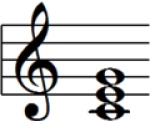
Music Theory 101
You may have heard of a basic musical concept referenced as “Playing by Ear” or “Ear Training”. What does it mean and is it possible for you to train your ear to play a banjo, guitar or mandolin? With a little practice, you might be surprised what you can accomplish.
Since childhood, we have been exposed to music in some form or the other. Some of you may have been a part of an elementary choral group. Others may have played a band instrument for your school. If you did not play an instrument or sing, you still have been exposed to basic childhood songs or nursery rhymes.
This idea of playing by ear is nothing new. One aspect of playing by ear is for the music student to take a common melody line and attempt to recreate the notes on the instrument. In other words, don’t look at a sheet of music to play a tune but make an attempt to develop the melody line from scratch by playing and listening to the notes in the correct order. For those of you who claim you are tone deaf, don’t approach this exercise as though it is a futile attempt. Keep Practicing!
Here are some tips for learning how to play melody lines:
(1) Start with a simple child’s melody line like Row Row Row your boat.
(2) First, hum or sing the song, referencing whether you are moving towards a higher or lower in pitch with each note.
(3) Next play the melody line using only one string on your banjo, guitar or mandolin.
(4) Play the notes as though you were speaking word for word, and play up and down the fingerboard on the one string.
(5) Pay attention to the fact that the melody line of a song does not necessarily begin on the root note of a major scale.
(6) Once you have mastered playing a simple tune, now move on to developing melody lines of other songs you would like to learn.
(7) As you progress and build confidence, try those new melody lines using multiple strings and play from chord positions.
With a little practice, you will be on your way towards creating your own melody lines with your instrument.

About fretmentor
Born in Detroit, Michigan, David F. Jakubiak has been involved in music since the age of 7, beginning as a clarinet player and then at 9 turning his attention to stringed instruments. He earned trophies in group talent competitions while a student at the University of Michigan. The instructor earned a BA degree in Organizational Psychology from the University of Michigan and a Masters in Public Administration at the University of Kansas. At college, he also studied classical music and music history.
His passion is teaching music and in performing as a musician. In addition to on-stage performances, David has played in various venues from outdoor festivals to small nightclubs. He plays, performs and teaches various styles of music, including rock, pop, blues, jazz, classical, country and bluegrass styles. He performs and teaches acoustic and electric guitar, five-string banjo, and mandolin. His styles range from Scruggs, melodic, Reno and old-time style on banjo, to finger-style and flat-picking technique on guitar, to various styles of mandolin.
For over 45 years, Mr. Jakubiak has taught all age groups, taking a personal interest in each student to ensure that they receive the attention and lesson plans that meet their needs and interests. His lessons and instructional materials place a strong emphasis on the practical use or music theory to ensure that the student understands the instrument and learns how to improvise to develop their own style. Mr Jakubiak teaches group and studio classes, webcam lessons over the internet, and individual private lessons to students of various ages. He has compiled and produced eight instructional books on CD as well as numerous instrumental arrangements.
David has written for Banjo Newsletter, a monthly publication for the banjo enthusiast and has published an article in Issue #37 of the Fretboard Journal. He is the founder of www.fretmentor.com.
To contact David Jakubiak, please feel free to e-mail him at david AT fretmentor.com (substitute the @ sign for the word AT)


I know this is true because I’ve done this on the piano many times….but it takes me a very long time. I do find it easier to see the music first, as I have a pretty good memory, I can memorize it faster than I can figure it out…..